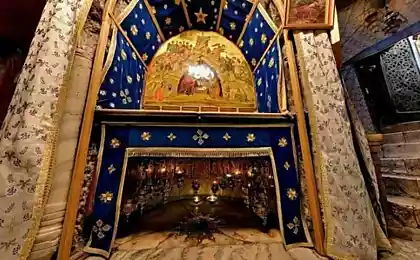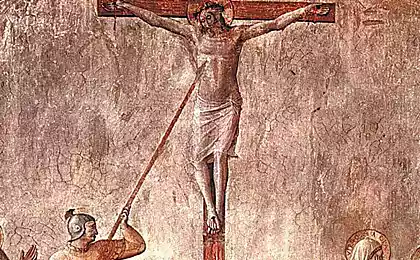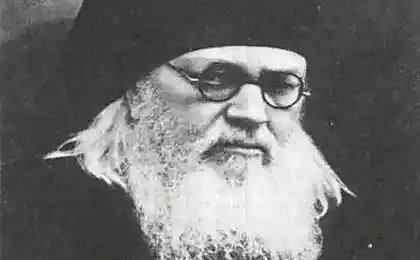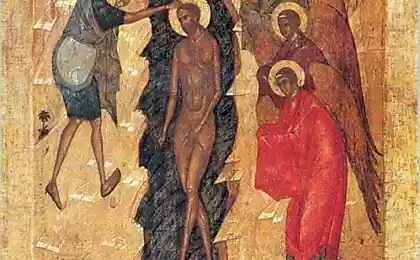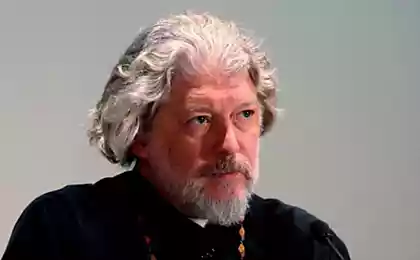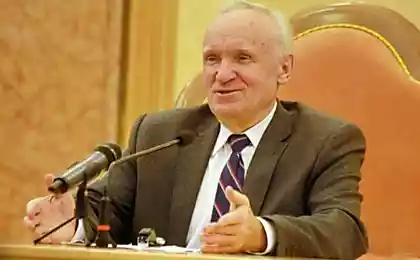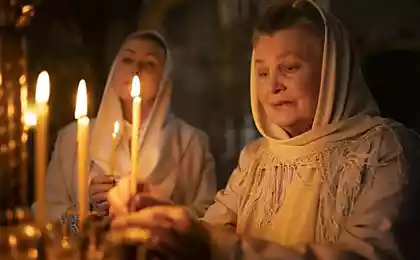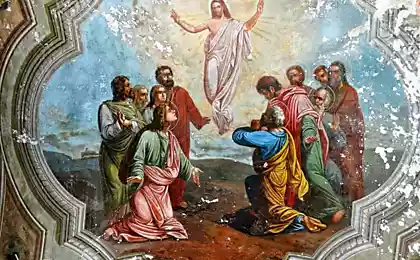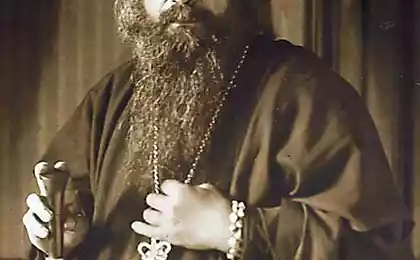724
Seven facts about Christmas
Christmas is the second most important Christian feast after Easter. We love him since childhood. And believe we know everything, history, traditions and legends. Some of us and all the Christmas services know by heart. Tell about little-known facts about the Nativity.
In what year Christ was born?
It would seem, all is simple: the new era is counted from the birth of Christ. But initially in the calculations were admitted the error: the Roman compiler of the Paschal Abbot Dionysius Small (worked in 525) was wrong for several years.
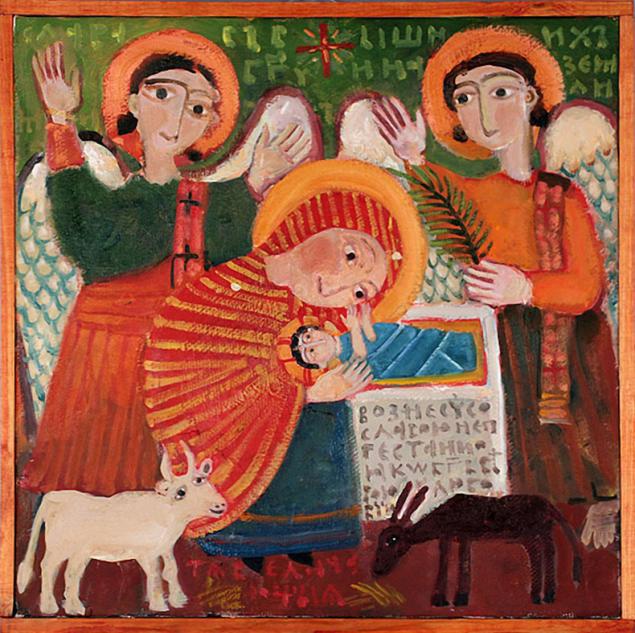
To accurately determine the date of the birth of Jesus Christ is difficult: from the gospel of Matthew it is known that during the beating infants to Christ were not more than two years. Amid all the cruelty of king Herod the Great this event in a small town in the environs of Jerusalem are unlikely to be particularly significant for the country, why in documents it is not reflected.
Herod the Great died in 750 year from the Foundation of Rome — we rate it a 4 BC At this time, the Savior was still a child, says the Apostle and Evangelist Matthew: "but when Herod was dead, behold, an angel of the Lord appeareth in a dream to Joseph in Egypt saying, arise, and take the young child and His mother, and go into the land of Israel for they are dead which sought the young child. He stood up, took the child and His mother, and came into the land of Israel (2:19-21). The Greek word παῖς can mean not only infant, but any child, and children in the Jewish tradition, boys are considered to 13 years.
Another clue — the year of John the Baptist in the sermon. Luke calls it exactly: "In the fifteenth year of the reign of Tiberius Caesar" (3:1) is this date calculated 28 ad At this time (or later) to Christ about thirty years — because the sermon, he goes after his Baptism by John. Exactly thirty He could not be, because then it would have turned out that the Nativity took place after Herod the Great, but this is "about thirty" and not "about forty." If we assume that Christ goes to preach at 28 year of age, at the very least, 32 years old, and most — 35 — the year of His birth varies in the range from 7 to 4 BC
Why Herod feared the news of the Birth of the Messiah?
In those years of the Messianic expectations of the Jewish people was particularly strong. Judea was under the rule of the pagan Romans, and the perceived Messiah king who would cast off the enemies and restore the Kingdom of Israel. That is His role, be sure all religious Jews — and the descendants of kings, and simple fishermen and farmers.
But Herod was not — it belongs to the faith of the Jewish people was formal, purely political.
Herod could not be a legitimate king of the Jews, as he was not a descendant of David. By birth, Herod was an Idumean, not a Jew. Judaism took not to himself, but his grandfather Antipas, and at the behest of the heart, and because of Hasmonean Jewish Kingdom.
Herod's father Antipater, was appointed Procurator of Judea and the place of the guardian of the Jewish king and high priest Hyrcanus II from the dynasty of the Maccabees. Risen, he seized the throne.
Antipater victim of a conspiracy. His son Herod killed the conspirators, and took power into their own hands.
To lend legitimacy to his rule, he married the granddaughter of Hyrcanus II, to prove yourself a godly man — reconstructed Temple. In 25 BC he solved the problem of starvation due to crop failures in Judea, exchanging all the gold in the Palace of bread in Egypt. But his cruelty and suspicion (he killed his wife and sons, Alexander, Aristobulus and Antipater, accused of conspiracy), his apparent cooperation with the occupiers (the power he got with the help of the Romans — with the support of Mark Antony, he was elected to the Senate in Rome), have all contributed to the fact that of the popularity of the people he has won.
The king's suspicion increased. The news of the birth of the Messiah was not joyful for him — he was not interested in the liberation of the Jewish people (and especially not the education of other peoples with the light of true faith, which also waited for the believers), and the preservation of power.
"Massacre of the innocents (Matteo di Giovanni, 1488)
The thirst for power has repeatedly turned Herod, the proud and the impostor, even in the brutal killer — but the massacre of the innocents has surpassed his previous crimes. After that, he spent more than three years (most likely even less).
Why the Magi came to worship the Christ?
It is well known that the Magi described in Matthew's gospel most likely came from Persia and were apparently astronomers (at the time, astronomy is closely intersected with astrology). And that's why they had to worship Christ, they do not know everything.
The word "Magi" since ancient times was called Zoroastrian priests. Common in Persia, Zoroastrianism, or Mazdaism, is the first monotheistic religion addressed to all mankind and not to a specific people.
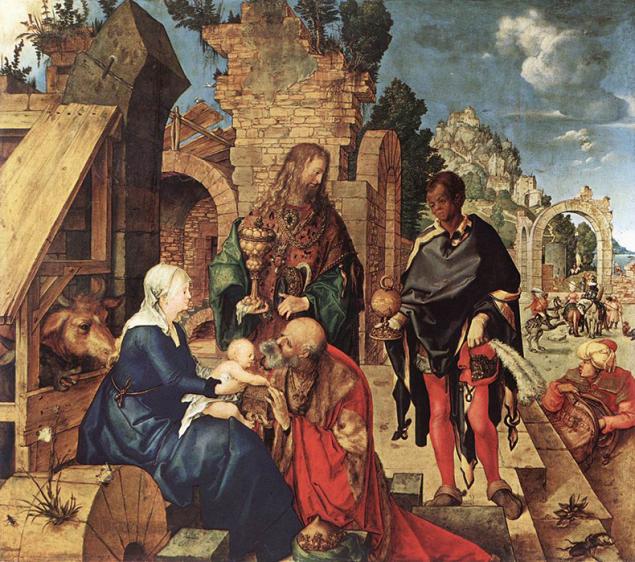
Albrecht Dürer. The adoration of the Magi. 1504, Uffizi Gallery, Florence, Italy
Historical and cultural ties between Ancient Israel and Persia were present for centuries, the Jews were captured by the Persians; the action of certain old Testament books occurs in Persia (book of Daniel, the book of Esther).
In General, the Persians and the Jews favorably perceived each other as bearers of the faith in one God.
Many of the motifs of "good faith" (as they call themselves Zoroastrians — the term 'Zoroastrianism' is used by Europeans to refer to this religion named after its prophet Zoroaster Spitama) is close to Judaism. In particular, eschatology, including resurrection of the dead and the last judgment, in both religions are practically the same.
The Hebrew doctrine of the Mashiach (Messiah) is proclaimed the coming of the Tsar-Liberator and echoes the Zoroastrian conception of Saoshyant three saviors, which in turn will come in the end time and people will pay Good faith. The third Saoshyant together with all the believers will win destructive force druj (evil spirit — Angra) and will resurrect the dead. Then the world will be transformed to a state of primordial perfection — is changing the world called "Fraso-kereti".
Being a supranational religion, Mazdaism did not see any obstacles to ensure that Saoshyant came from the Jews, who knew the Zoroastrians, also waiting for a Savior King.
That's why the new star of the King of Judah the Savior of the world took three scientists the priests in ancient Jerusalem.
How do we know about the cave of the Nativity?
From the gospel of Luke we know that as a cradle for the Baby the virgin Mary used a manger — a feeding trough for cattle.
The Catholic Church keeps in the Roman Church of Santa Maria Maggiore of the Christmas Shrine — a wooden plank considered to be a particle of the manger of Christ. However, about the historical authenticity of this item is uncertain. Throughout the Holy Land and now you can see caves in the rocks, which in ancient times was used for sheltering cattle, but the manger made of stone — because in this area a tree is not a common material.
But, in any case, the manger in the Scripture mentioned.
But the cave is not a word. How do we know about the place of birth of the Savior?
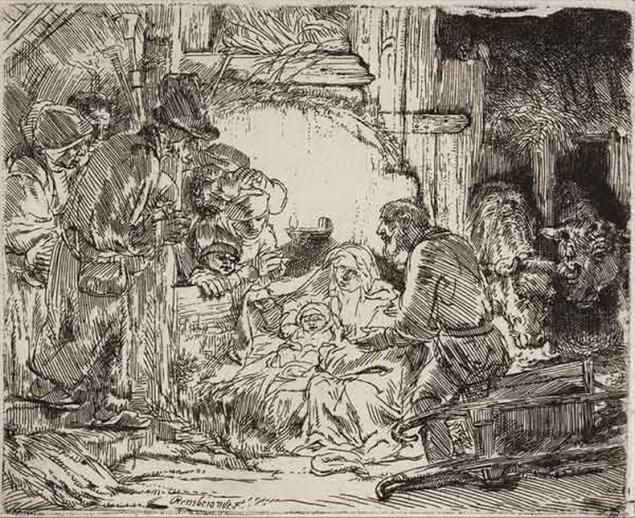
Rembrandt Harmenszoon van Rijn. Engraving. 1654
The first written mention of the cave in which Christ was born, we find in the sources of mid-second century: of the apocryphal "Gospel of James" and "Dialogue with Tryphon the Jew" Holy Martyr Justin the Philosopher.
If the "Gospel" is full of many historically inaccurate details, Justin the Philosopher captures the oral tradition, in General, do not differ from those described in the gospel: "When the baby time born in Bethlehem, then Joseph, the drawback is the village of where to stay, came to a certain cave near the village. And when they were there, Mary gave birth to Christ and laid Him in a manger. The exact place St. Justin indicates.
They are very accurately indicates the place of the Nativity visited the Holy places of Origen. "The cave of Bethlehem indicates where He was born, and the manger of the cave testify to the fact where he was povit clothes, – he reports in his work "Against Celsus." – In those places alive for another legend about this event, known even to the enemies of the faith, that in that cave was born Jesus, Who is revered and Who marvel at Christians."
What is the enemies of the faith?
In the middle of the II century Judea there was a major revolt against Rome under the leadership of Bar Kochba (among the Jews even had a notion that this man is the promised Messiah). The rebellion was brutally suppressed. Emperor Hadrian destroyed the Temple in Jerusalem, and in fact all of Jerusalem, expelled the Jews, forbidding even come close to the Holy city (just on the eve of Passover they could look at it from the mountain, to this day called "har ha-Tsofim" – mountain View was built on the ruins of the colony new name of Aelia Capitolina, and even the very province of Judea was renamed to Palestine.
In the grim irony of the Bible the land was named in honor of the people, which fought the old Testament judges and the king David of the Philistines.
In an effort to erase from the earth the very memory of the people who lived here, Adrian destroys shrines of the Christians, perceiving them as a Jewish sect. In the Ancient Church it was customary to gather for the Eucharist in the monuments — and the Christmas cave is no exception. Adrian tells him to build on them the pagan temples. According to the testimony of the translator of Scripture into Latin, St. Jerome of Stridon, "the very cave where the Infant Christ uttered His first cry crying, was dedicated to the lover of Venus.
But the memory of the cave was preserved during the first centuries of Christianity, and this place was described in the middle of the third century Origen.
It will take several decades, and Saint Helena will begin the search for Christian relics. Thanks to the maniacal revenge Hadrian tried to desecrate and destroy their pagan rituals, Holy places were easy: they pointed out the pagan altars.
Why Christmas symbol — tree?
From the stories we pass to the legends and folk customs.
Many are familiar with good European fairy tale about a tree, which when the trees came to worship the Infant Christ, humbly stood in the doorway, not having gifts and being afraid to stab It, while other trees do not give her fruit, nuts, flowers, apples, oranges so she could give the Savior (according to another version, the Christmas tree decorated with stars angel). Christ smiled and reached out to the sapling, and so the fir tree became the symbol of Christmas.
But why is there this legend, known not for everyone.
In the Germanic tribes long before the adoption of Christianity, evergreens were a symbol of life. It was believed, they protect homes from evil spirits, darkness and cold.
In the Middle ages the Germans all winter long decorated the homes of juniper or spruce.
And in the historical sources for the first time a Christmas tree is mentioned in 1419 in Freiburg by the local bakers decorated the tree with fruits, nuts and biscuits, leaving the children to "looting" in the New year.
In Russia the Christmas tree tried to "impose" Peter I, which is also well-known, but by Christmas it had no relationship — fir branches decorated the town for the New year.
Christmas trees appeared due to come to Petersburg to the Germans at the beginning of the XIX century, and first drew the highest light, and that is far not at once — only on the eve of 1840, the newspaper "Northern bee" advertises sold decorated Christmas tree, and a year reports a new tradition as taken over from the Germans a good children's party on the eve of Christmas... the Tree lit with lamps or candles, decked with sweets, fruits, toys, books, is the joy of children who had already been told, what is good behavior and diligence in the festival will appear sudden rewarding".
In people, the Christmas tree caught on at once, and it is not in opposition to non-Orthodox innovation. Spruce in Russia is not loved: she grew up in the swamp, was unpleasant to the touch (scratchy, wet mossy trunk) and represented, in contrast to the Western European tradition, evil spirits and death. Hence — preserved to this day the custom to cover the fresh graves with fir branches (however, in the last century, it is already reinterpreted in a Christian way, thanks largely adopted in the Western Christian notion of the tree — the symbol of life).
Only at the end of the XIX century, the fir tree and in Russia, becoming a Christmas symbol.
And today, Christmas and the Christmas tree can be found even among Orthodox Christians of the East and in the hometown of the Savior surrounded by the desert, Bethlehem, in the Windows of shops are decorated with Christmas trees and Santa Claus with sledge and deer.
When celebrating Christmas early Christians?
But they did not specifically celebrated. Christians from the fourth century celebrated the Epiphany, which included the second coming of the Lord into the world, Christmas, the phenomenon of the Child Jesus in the Temple, and the output of the Christ to the preaching after his Baptism in the Jordan. In the Churches of Rome and North Africa, this day fell on 25 December and in the Churches of the East and Gaul — January 6.
Where did these dates?
The early Church learned the ancient Jewish tradition, where the date of death of the Holy man coincides with the date of his birth (for example, 6 of the month of Sivan was born and died king David, the 15th of Sivan was born and died son of father Jacob, Judah, 10 ava was born and died son of the forefather Jacob, Issachar...).
The Christians found out the day of the incarnation, that is, of the Annunciation, when she conceived the Lord Jesus Christ, based on the date of Easter — the Resurrection of Christ — a calculated Easter differently. One, focusing on the solar calendar added 14 days to the day of the vernal equinox (March 22) and celebrated the Passover on the Sunday nearest to the 6th of April, while others, following tradition, coming from Tertullian and other relevant ancient sources (a treatise "On the calculation of Easter," attributed to SVT. Cyprian of Carthage, etc.), believed that the Suffering of Christ was on the eighth of April calends — i.e., March 25.
Accordingly, simple addition of 6 April and 25 March received the feast of the Epiphany — Christmas and Epiphany. Some teachers of the Church (Clement of Alexandria, Origen, SVT. Athanasius the Great) was correlated on this day with the Baptism in the Jordan, others. Epiphanius, venerable. Ephrem the Syrian) — with Christmas.
The Christmas theme was Central to the feast of the Epiphany, in particular, was considered an important motive of the adoration of the Magi as the revelation of the Lord Jesus Christ to the Gentile world.
Why is a more common date of January 6 was divided into two and why the allocation of the Nativity as a separate feast on December 25?
Most persuasive is the view according to which it was apologetic reasons. First, in 70-80s of the IV century strengthened the position of the Orthodox against the Arians.
The selection of individual holiday dedicated in the flesh the birth of our Lord Jesus Christ, made it possible to emphasize adenosie His Father.
Secondly, December 25, on the third day after the winter solstice in the pagan world celebrated the "feast of the invincible sun". The celebration, accompanied by the ceremony of kindling the lights was so widespread that it was attended by Christians. Augustine called to celebrate this day the birth of Christ, "not as incorrect for the sun, but for the sake of the one Who created this sun."
Still in the Armenian Church (Ahalkalaki) celebrated Christmas and Epiphany, and the feast of the Epiphany — January 6.
When we celebrate Christmas in the XXII century?
The question seems funny, because the Church calendar is unchanged, and hence we will have to celebrate Christmas on the same day as today, that is December 25 according to the Julian calendar, or 7 January in the Gregorian calendar.
Meanwhile, Julian, that is the ecclesiastical or old calendar, the calendar does not change, but the Gregorian, that is "civil" or "new" changes the rules according to which the gap between the old and the new style will gradually increase.
We are accustomed to the fact that leap years are those years that are divisible by four. But this rule is only valid for the Julian calendar. For "civil" Gregorian rules for leap years as follows:
— if the sequence number of the year does not end with two zeros and is divisible by 4, then leap year;
— if the sequence number of the year ends in two zeros, and the number of hundreds in the sequence number years evenly divisible by 4 is a leap year, and if not divisible, then a is simple.
Thus, the year 1900 is easy, 2000 is a leap year, 2100 is simple. Consequently, on March 1, 2100 the gap between the Julian and the Gregorian calendar will increase by one day, and 2101 Christmas will be celebrated on 8 January by the new style that will match the 25 Dec in the old.
Of course, shift all the other neperehodimyh holidays.
Oddly enough, Orthodox Churches living in the old style, can face a serious problem — now there are people even among the priests who believe that this shift is a violation of liturgical tradition and categorically unacceptable. Of course, sensible people will deal with the problem of addition within the same unit, but the psychological discomfort they are — because in everyday life we orientirueshsya on the civil calendar.
It is hoped that the government will be reasonable and will shift the day 7 January 8. published
Author: Maria Senchukova
P. S. And remember, only by changing their consumption — together we change the world! © Join us at Facebook , Vkontakte, Odnoklassniki
Source: www.pravmir.ru/sem-faktov-o-rozhdestve/
In what year Christ was born?
It would seem, all is simple: the new era is counted from the birth of Christ. But initially in the calculations were admitted the error: the Roman compiler of the Paschal Abbot Dionysius Small (worked in 525) was wrong for several years.

To accurately determine the date of the birth of Jesus Christ is difficult: from the gospel of Matthew it is known that during the beating infants to Christ were not more than two years. Amid all the cruelty of king Herod the Great this event in a small town in the environs of Jerusalem are unlikely to be particularly significant for the country, why in documents it is not reflected.
Herod the Great died in 750 year from the Foundation of Rome — we rate it a 4 BC At this time, the Savior was still a child, says the Apostle and Evangelist Matthew: "but when Herod was dead, behold, an angel of the Lord appeareth in a dream to Joseph in Egypt saying, arise, and take the young child and His mother, and go into the land of Israel for they are dead which sought the young child. He stood up, took the child and His mother, and came into the land of Israel (2:19-21). The Greek word παῖς can mean not only infant, but any child, and children in the Jewish tradition, boys are considered to 13 years.
Another clue — the year of John the Baptist in the sermon. Luke calls it exactly: "In the fifteenth year of the reign of Tiberius Caesar" (3:1) is this date calculated 28 ad At this time (or later) to Christ about thirty years — because the sermon, he goes after his Baptism by John. Exactly thirty He could not be, because then it would have turned out that the Nativity took place after Herod the Great, but this is "about thirty" and not "about forty." If we assume that Christ goes to preach at 28 year of age, at the very least, 32 years old, and most — 35 — the year of His birth varies in the range from 7 to 4 BC
Why Herod feared the news of the Birth of the Messiah?
In those years of the Messianic expectations of the Jewish people was particularly strong. Judea was under the rule of the pagan Romans, and the perceived Messiah king who would cast off the enemies and restore the Kingdom of Israel. That is His role, be sure all religious Jews — and the descendants of kings, and simple fishermen and farmers.
But Herod was not — it belongs to the faith of the Jewish people was formal, purely political.
Herod could not be a legitimate king of the Jews, as he was not a descendant of David. By birth, Herod was an Idumean, not a Jew. Judaism took not to himself, but his grandfather Antipas, and at the behest of the heart, and because of Hasmonean Jewish Kingdom.
Herod's father Antipater, was appointed Procurator of Judea and the place of the guardian of the Jewish king and high priest Hyrcanus II from the dynasty of the Maccabees. Risen, he seized the throne.
Antipater victim of a conspiracy. His son Herod killed the conspirators, and took power into their own hands.
To lend legitimacy to his rule, he married the granddaughter of Hyrcanus II, to prove yourself a godly man — reconstructed Temple. In 25 BC he solved the problem of starvation due to crop failures in Judea, exchanging all the gold in the Palace of bread in Egypt. But his cruelty and suspicion (he killed his wife and sons, Alexander, Aristobulus and Antipater, accused of conspiracy), his apparent cooperation with the occupiers (the power he got with the help of the Romans — with the support of Mark Antony, he was elected to the Senate in Rome), have all contributed to the fact that of the popularity of the people he has won.
The king's suspicion increased. The news of the birth of the Messiah was not joyful for him — he was not interested in the liberation of the Jewish people (and especially not the education of other peoples with the light of true faith, which also waited for the believers), and the preservation of power.
"Massacre of the innocents (Matteo di Giovanni, 1488)
The thirst for power has repeatedly turned Herod, the proud and the impostor, even in the brutal killer — but the massacre of the innocents has surpassed his previous crimes. After that, he spent more than three years (most likely even less).
Why the Magi came to worship the Christ?
It is well known that the Magi described in Matthew's gospel most likely came from Persia and were apparently astronomers (at the time, astronomy is closely intersected with astrology). And that's why they had to worship Christ, they do not know everything.
The word "Magi" since ancient times was called Zoroastrian priests. Common in Persia, Zoroastrianism, or Mazdaism, is the first monotheistic religion addressed to all mankind and not to a specific people.

Albrecht Dürer. The adoration of the Magi. 1504, Uffizi Gallery, Florence, Italy
Historical and cultural ties between Ancient Israel and Persia were present for centuries, the Jews were captured by the Persians; the action of certain old Testament books occurs in Persia (book of Daniel, the book of Esther).
In General, the Persians and the Jews favorably perceived each other as bearers of the faith in one God.
Many of the motifs of "good faith" (as they call themselves Zoroastrians — the term 'Zoroastrianism' is used by Europeans to refer to this religion named after its prophet Zoroaster Spitama) is close to Judaism. In particular, eschatology, including resurrection of the dead and the last judgment, in both religions are practically the same.
The Hebrew doctrine of the Mashiach (Messiah) is proclaimed the coming of the Tsar-Liberator and echoes the Zoroastrian conception of Saoshyant three saviors, which in turn will come in the end time and people will pay Good faith. The third Saoshyant together with all the believers will win destructive force druj (evil spirit — Angra) and will resurrect the dead. Then the world will be transformed to a state of primordial perfection — is changing the world called "Fraso-kereti".
Being a supranational religion, Mazdaism did not see any obstacles to ensure that Saoshyant came from the Jews, who knew the Zoroastrians, also waiting for a Savior King.
That's why the new star of the King of Judah the Savior of the world took three scientists the priests in ancient Jerusalem.
How do we know about the cave of the Nativity?
From the gospel of Luke we know that as a cradle for the Baby the virgin Mary used a manger — a feeding trough for cattle.
The Catholic Church keeps in the Roman Church of Santa Maria Maggiore of the Christmas Shrine — a wooden plank considered to be a particle of the manger of Christ. However, about the historical authenticity of this item is uncertain. Throughout the Holy Land and now you can see caves in the rocks, which in ancient times was used for sheltering cattle, but the manger made of stone — because in this area a tree is not a common material.
But, in any case, the manger in the Scripture mentioned.
But the cave is not a word. How do we know about the place of birth of the Savior?

Rembrandt Harmenszoon van Rijn. Engraving. 1654
The first written mention of the cave in which Christ was born, we find in the sources of mid-second century: of the apocryphal "Gospel of James" and "Dialogue with Tryphon the Jew" Holy Martyr Justin the Philosopher.
If the "Gospel" is full of many historically inaccurate details, Justin the Philosopher captures the oral tradition, in General, do not differ from those described in the gospel: "When the baby time born in Bethlehem, then Joseph, the drawback is the village of where to stay, came to a certain cave near the village. And when they were there, Mary gave birth to Christ and laid Him in a manger. The exact place St. Justin indicates.
They are very accurately indicates the place of the Nativity visited the Holy places of Origen. "The cave of Bethlehem indicates where He was born, and the manger of the cave testify to the fact where he was povit clothes, – he reports in his work "Against Celsus." – In those places alive for another legend about this event, known even to the enemies of the faith, that in that cave was born Jesus, Who is revered and Who marvel at Christians."
What is the enemies of the faith?
In the middle of the II century Judea there was a major revolt against Rome under the leadership of Bar Kochba (among the Jews even had a notion that this man is the promised Messiah). The rebellion was brutally suppressed. Emperor Hadrian destroyed the Temple in Jerusalem, and in fact all of Jerusalem, expelled the Jews, forbidding even come close to the Holy city (just on the eve of Passover they could look at it from the mountain, to this day called "har ha-Tsofim" – mountain View was built on the ruins of the colony new name of Aelia Capitolina, and even the very province of Judea was renamed to Palestine.
In the grim irony of the Bible the land was named in honor of the people, which fought the old Testament judges and the king David of the Philistines.
In an effort to erase from the earth the very memory of the people who lived here, Adrian destroys shrines of the Christians, perceiving them as a Jewish sect. In the Ancient Church it was customary to gather for the Eucharist in the monuments — and the Christmas cave is no exception. Adrian tells him to build on them the pagan temples. According to the testimony of the translator of Scripture into Latin, St. Jerome of Stridon, "the very cave where the Infant Christ uttered His first cry crying, was dedicated to the lover of Venus.
But the memory of the cave was preserved during the first centuries of Christianity, and this place was described in the middle of the third century Origen.
It will take several decades, and Saint Helena will begin the search for Christian relics. Thanks to the maniacal revenge Hadrian tried to desecrate and destroy their pagan rituals, Holy places were easy: they pointed out the pagan altars.
Why Christmas symbol — tree?
From the stories we pass to the legends and folk customs.
Many are familiar with good European fairy tale about a tree, which when the trees came to worship the Infant Christ, humbly stood in the doorway, not having gifts and being afraid to stab It, while other trees do not give her fruit, nuts, flowers, apples, oranges so she could give the Savior (according to another version, the Christmas tree decorated with stars angel). Christ smiled and reached out to the sapling, and so the fir tree became the symbol of Christmas.
But why is there this legend, known not for everyone.
In the Germanic tribes long before the adoption of Christianity, evergreens were a symbol of life. It was believed, they protect homes from evil spirits, darkness and cold.
In the Middle ages the Germans all winter long decorated the homes of juniper or spruce.
And in the historical sources for the first time a Christmas tree is mentioned in 1419 in Freiburg by the local bakers decorated the tree with fruits, nuts and biscuits, leaving the children to "looting" in the New year.
In Russia the Christmas tree tried to "impose" Peter I, which is also well-known, but by Christmas it had no relationship — fir branches decorated the town for the New year.
Christmas trees appeared due to come to Petersburg to the Germans at the beginning of the XIX century, and first drew the highest light, and that is far not at once — only on the eve of 1840, the newspaper "Northern bee" advertises sold decorated Christmas tree, and a year reports a new tradition as taken over from the Germans a good children's party on the eve of Christmas... the Tree lit with lamps or candles, decked with sweets, fruits, toys, books, is the joy of children who had already been told, what is good behavior and diligence in the festival will appear sudden rewarding".
In people, the Christmas tree caught on at once, and it is not in opposition to non-Orthodox innovation. Spruce in Russia is not loved: she grew up in the swamp, was unpleasant to the touch (scratchy, wet mossy trunk) and represented, in contrast to the Western European tradition, evil spirits and death. Hence — preserved to this day the custom to cover the fresh graves with fir branches (however, in the last century, it is already reinterpreted in a Christian way, thanks largely adopted in the Western Christian notion of the tree — the symbol of life).
Only at the end of the XIX century, the fir tree and in Russia, becoming a Christmas symbol.
And today, Christmas and the Christmas tree can be found even among Orthodox Christians of the East and in the hometown of the Savior surrounded by the desert, Bethlehem, in the Windows of shops are decorated with Christmas trees and Santa Claus with sledge and deer.
When celebrating Christmas early Christians?
But they did not specifically celebrated. Christians from the fourth century celebrated the Epiphany, which included the second coming of the Lord into the world, Christmas, the phenomenon of the Child Jesus in the Temple, and the output of the Christ to the preaching after his Baptism in the Jordan. In the Churches of Rome and North Africa, this day fell on 25 December and in the Churches of the East and Gaul — January 6.
Where did these dates?
The early Church learned the ancient Jewish tradition, where the date of death of the Holy man coincides with the date of his birth (for example, 6 of the month of Sivan was born and died king David, the 15th of Sivan was born and died son of father Jacob, Judah, 10 ava was born and died son of the forefather Jacob, Issachar...).
The Christians found out the day of the incarnation, that is, of the Annunciation, when she conceived the Lord Jesus Christ, based on the date of Easter — the Resurrection of Christ — a calculated Easter differently. One, focusing on the solar calendar added 14 days to the day of the vernal equinox (March 22) and celebrated the Passover on the Sunday nearest to the 6th of April, while others, following tradition, coming from Tertullian and other relevant ancient sources (a treatise "On the calculation of Easter," attributed to SVT. Cyprian of Carthage, etc.), believed that the Suffering of Christ was on the eighth of April calends — i.e., March 25.
Accordingly, simple addition of 6 April and 25 March received the feast of the Epiphany — Christmas and Epiphany. Some teachers of the Church (Clement of Alexandria, Origen, SVT. Athanasius the Great) was correlated on this day with the Baptism in the Jordan, others. Epiphanius, venerable. Ephrem the Syrian) — with Christmas.
The Christmas theme was Central to the feast of the Epiphany, in particular, was considered an important motive of the adoration of the Magi as the revelation of the Lord Jesus Christ to the Gentile world.
Why is a more common date of January 6 was divided into two and why the allocation of the Nativity as a separate feast on December 25?
Most persuasive is the view according to which it was apologetic reasons. First, in 70-80s of the IV century strengthened the position of the Orthodox against the Arians.
The selection of individual holiday dedicated in the flesh the birth of our Lord Jesus Christ, made it possible to emphasize adenosie His Father.
Secondly, December 25, on the third day after the winter solstice in the pagan world celebrated the "feast of the invincible sun". The celebration, accompanied by the ceremony of kindling the lights was so widespread that it was attended by Christians. Augustine called to celebrate this day the birth of Christ, "not as incorrect for the sun, but for the sake of the one Who created this sun."
Still in the Armenian Church (Ahalkalaki) celebrated Christmas and Epiphany, and the feast of the Epiphany — January 6.
When we celebrate Christmas in the XXII century?
The question seems funny, because the Church calendar is unchanged, and hence we will have to celebrate Christmas on the same day as today, that is December 25 according to the Julian calendar, or 7 January in the Gregorian calendar.
Meanwhile, Julian, that is the ecclesiastical or old calendar, the calendar does not change, but the Gregorian, that is "civil" or "new" changes the rules according to which the gap between the old and the new style will gradually increase.
We are accustomed to the fact that leap years are those years that are divisible by four. But this rule is only valid for the Julian calendar. For "civil" Gregorian rules for leap years as follows:
— if the sequence number of the year does not end with two zeros and is divisible by 4, then leap year;
— if the sequence number of the year ends in two zeros, and the number of hundreds in the sequence number years evenly divisible by 4 is a leap year, and if not divisible, then a is simple.
Thus, the year 1900 is easy, 2000 is a leap year, 2100 is simple. Consequently, on March 1, 2100 the gap between the Julian and the Gregorian calendar will increase by one day, and 2101 Christmas will be celebrated on 8 January by the new style that will match the 25 Dec in the old.
Of course, shift all the other neperehodimyh holidays.
Oddly enough, Orthodox Churches living in the old style, can face a serious problem — now there are people even among the priests who believe that this shift is a violation of liturgical tradition and categorically unacceptable. Of course, sensible people will deal with the problem of addition within the same unit, but the psychological discomfort they are — because in everyday life we orientirueshsya on the civil calendar.
It is hoped that the government will be reasonable and will shift the day 7 January 8. published
Author: Maria Senchukova
P. S. And remember, only by changing their consumption — together we change the world! © Join us at Facebook , Vkontakte, Odnoklassniki
Source: www.pravmir.ru/sem-faktov-o-rozhdestve/

